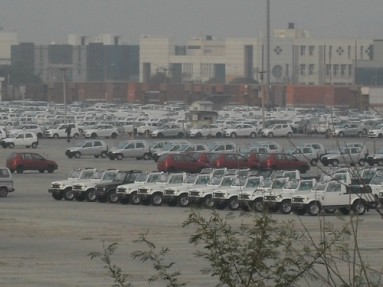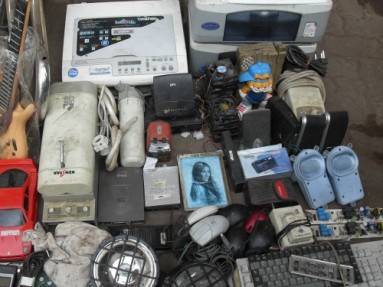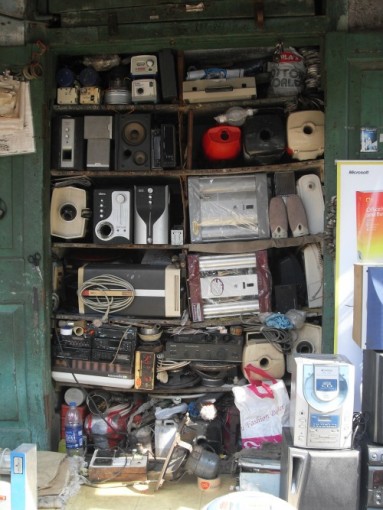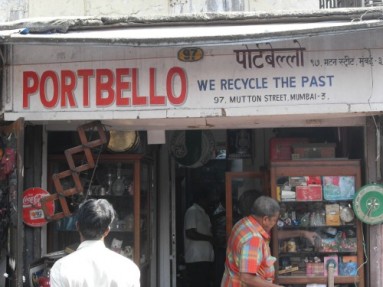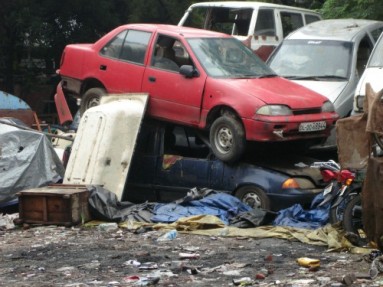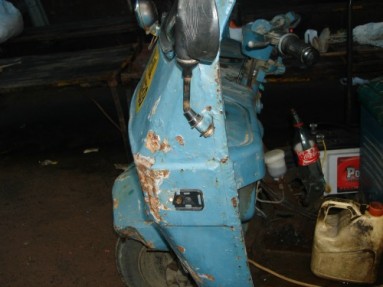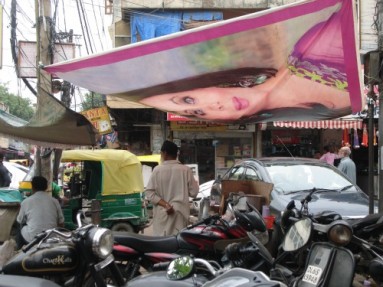India is, as anthropologist Arjun Appadurai refers to it, is a “bazaar of thingness,” where stuff proliferates in excess of any attempts at categorization or classification. In informal markets this proliferation of things can be seen in the seemingly haphazard way in which merchants often display their wares: for instance, steel utensils and plastic kitchen items sit next to bags, books, sweaters, handkerchiefs, pants, colorful plastic garlands, plastic stools, mirrors, and the odd knock-off deodorant can. Such a sheer profusion of things in the bazaar, defying any apparent logic of arrangement, can become an important lens through which we can reconsider the very idea of the market.
Juxtapose the cornucopia of objects found in the bazaar with an image like the one below – of the massive Maruti Suzuki factory in Gurgaon, a satellite city of Delhi, which has been the theatre of a bitter trade union struggle for the past year. The factory – photographed here from a height on a neighboring hill – is the quintessential site of formal organization, lending itself naturally to surveillance and control. Here everything is neat, ordered, measured; nothing is placed without a plan. The bazaar disrupts this form of arrangement and organization, it disrupts the form of looking that the formal factory space makes possible. While the factory is based on the logic of supervising work, the informal market is an immersive space: objects are often arranged to be trudged through, they are rarely labeled or packaged, and sometimes are clearly being resold.
The difference between the modes of looking encouraged in the bazaar and in the formal market place, determines the relationship between people and objects in these two spaces. The Maruti factory functions as an economy that approximates the conventional idea of what a market is. In such a marketplace, objects become repositories of exchange value of one kind or another. The logic of abstraction – as dominant in Western societies as in India's capitalist factories – sees to it that things are no longer enjoyed for their materiality. “Things” are translated into money, or abstract markers of wealth. As Appadurai remarks, a house could signify retirement; a car, insurance against isolation; a vacation home, a hedge against inflation. In the bazaar, by contrast, the distinction between the thing and the use of the thing blurs because of the immediate and material relationship between the two.
As we know from history, but also from the vast swathes of informal markets in the non-West today, not every market is capitalist. Opposed to the clean organization of things that dominates the capitalist marketplace, in the markets of informal labor scattered across a country like India, organization gives way to beautiful chaos. The struggle against capitalism is at least in part a struggle against a particular mode of organizing stuff. Capitalism dreams, everywhere, of a society where everything is regulated, stocked, accounted for, and arranged – preferably mechanically. But as Appadurai writes:
Indian society is a panorama of piles, stacks, bunches, bundles, baskets, bags among which people appear, as laborers, as shopkeepers, as vendors, as housewives, and as pedestrians, making their way through an endless landscape of things, ranging from the most precious to the most ugly and filthy. Things meld into bodies, especially in Indian society, where objects provide the material for people to sleep on, to live in, to rest on, to buy, to sell, to repair, to store, to trade, to scavenge, and to display.
This description moves seamlessly from the world of legitimate goods and commodities organized in informal markets to the gray world of pirate and illegitimate objects that circulate in different spaces. Indeed, in India every “thing” is a little gray. It is difficult to separate an original from a counterfeit, or the new from the old.
Much of this informal economy is powered by reuse. The waste commodity (which has outlived one function but still has many others) is therefore an important feature of the Indian bazaar. In such contexts, where the shining new commodity and the waste object both possess value of some kind, we need to focus more closely on the things themselves. These waste objects help us imagine informal relationships between people and objects.
The two photographs above capture one small corner of Mumbai’s famous chor bazaar (literally, “market of stolen goods”). The market rubs shoulders with a scrap yard (or scrap street, more accurately) that strips down cars and scooters and sells their components as cheap spares. Chor bazaar sells everything from used refrigerators and television sets to clocks, used table fans, old film posters, jazz records, gramophones, discarded computer speakers, out-of-date Nintendo players, keyboards, decorative curios, old cameras, video equipment from Mumbai’s enormous film industry, and even the odd antique piece of furniture salvaged from the homes of Parsi families fallen on hard times. In the pictures above we see goods that have made their way from both homes and film sets: an old framed photograph of a family member, computer keyboards, speakers, projectors, a printer, a scanner, a discarded exhaust fan, a mouse, a water purifier, a couple of modems, a guitar, a plastic red toy car, a Garfield knickknack, a small handheld camera.
The two pictures represent the different ways that goods are displayed: stacked, as well as horizontally on the street, squished together to make space for pedestrian traffic. The goods in the market are not necessarily stolen; locals who work in the area claim the word chor (thief) is a colonial era corruption of the word shor (noise). Historian Gyan Prakash has written eloquently, in his book Mumbai Fables, of the “montage effect” of organizing disparate things from different contexts next to each other, as is the case in this market. Such an organization defies logic and linear narration. Here we see both obsolete and useful objects as neighbors, and our engagement with them in this form produces a different experience of the market and city.
One of the central motifs of an informal mode of organizing stuff is captured on the signboard outside another shop in the same area which sells a combination of new, antique, legitimate, and contraband things. A single letter away from London's famous Portobello Road, the largest antiques market in the world, the sign seems to playfully mock the new capitalist ethic of recycling, which has become, ironically, a way for the Indian government to check informality and curb the reuse of things. If you force people to recycle obsolete goods, they cannot be resold and used for unauthorized purposes.
The stacks, bundles, and piles in the scrap yards and informal markets in Indian cities form another mode of looking, different from the organization of the capitalist factory or supermarket, which exist within a framework of heightened organization and supervision. They signal waste’s potential and call attention to the enduring uses things have even after they have served their capitalist function. In an age of planned obsolescence, the informal domain embraces the obsolete as a new beginning.
Nothing is inherently waste; objects become so when we deem them such. Capitalism, as we know by now, functions through a cogent value/waste dichotomy. The notion of value in capitalism can only be upheld in a context where there is also a notion of waste. But framing waste as the other that gives monetary value meaning restricts our imaginations. These seemingly haphazard and unwieldy spaces often classified as “informal” are rich fields of alternate relationships between people and things that challenge dominant paradigms of capitalism and the dominant value scheme.
In much of India, individuals who populate these informal spaces are capital's rejects. They are those who have been forcefully removed from their lands through the process of primitive accumulation but haven’t been absorbed in industrial jobs or other professions. As the late Indian economist Kalyan Sanyal argued in his book Rethinking Capitalist Development, in postcolonial contexts these individuals occupy a “wasteland”: a space outside of capitalist relations, without any prospect of being absorbed within it as such. They are just as much produced as waste as the waste objects that fall out of capitalist circulation.
The individuals who labor in the informal sector are not individuals in the abstract sense of Homo economicus but a very particular group of human waste expelled from the circuits of capital. As waste-people work with objects that are – or will become – waste, a new life develops around things.
In his essay “Thing Theory,” Bill Brown suggests that “We begin to confront the thingness of objects when they stop working for us: when the drill breaks, when the car stalls, when the windows get filthy, when their flow within the circuits of production and distribution, consumption and exhibition, has been arrested, however momentarily.”
The thing in this sense forces us to confront the excesses that lie beyond consumer capitalism’s ideal subject-object relationship, one governed by notions of private property, ownership, and obsolescence. All the things Brown mentions are, in some sense, waste. And although his examples all have an element of temporariness to them (that is, the things may return to being normal objects if fixed, repaired or cleaned), in the aforementioned wastelands of capital, the sense of temporariness gives way to a more stable, permanent state in which repurposing is one aspect of a different, noncapitalist relation to objects.
People construct transport vehicles (called jugaads) out of irrigation pumps for engines, spare steering columns and wheels from old jeeps or trucks, and often homemade wooden chassis. These vehicles are generally unregistered and their owners don’t pay road tax. They do not run faster than 40 kms/hr, although the variety in which the makeshift chassis of trucks are attached to old Enfield bullet motorbike engines do make better time. These vehicles are a cheap mode of public transportation in rural areas where bus services are infrequent. In spite of several laws attempting to phase out these indigenous vehicles, they move both people and produce from villages to the nearest local town.
Informal markets give old clothes a new lease of life with dye, commonly used on the street with a gas cylinder and a makeshift stove required to heat water. In the picture above, an old tray meant for carrying milk bottles is being used to store color for the dyeing process. Tetra-paks have become ubiquitous in India and are increasingly recycled. Indians often use this material, pictured above, to make rope that binds rudimentary wooden beds (charpoys). Old oil drums proliferate throughout the country as mobile bread kitchens (tandoors).
On a less elaborate scale, objects are used to fix things: discarded Bollywood posters printed on flex sheets form the shelter under which construction workers live or tea-shop owners set up temporary stalls. These flex sheets are suspended from electricity poles and trees, making an area in the middle of a road conducive for business during both heavy rain and sharp sunshine.
Three-wheeled vehicles that vendors use to transport goods are another good example of waste-based things. These carrier autos usually come with uncomfortable gear-sticks, consisting of thin metal welded to the base of the vehicle with very little external padding or embellishment. The coke bottle with its curved shape provides an interesting solution and a more comfortable grip.
All these instances show that the informal and the wasteland are not two separate domains; they are one and the same. Thinking through the materiality of informal things alerts us to the constraints of the conceptual function of terms like capitalism and the market. The relationship between people and things we find in such spaces allows us to come down from the lofty heights of abstraction to a base, sensual materiality. Putting a thing to nonintended uses or diverting it from the path of planned obsolescence presupposes a material engagement with its functions beyond those sanctioned by the clean world of expiry dates and warranty periods, prescribed by what we often unquestioningly accept as the way capitalism works.


